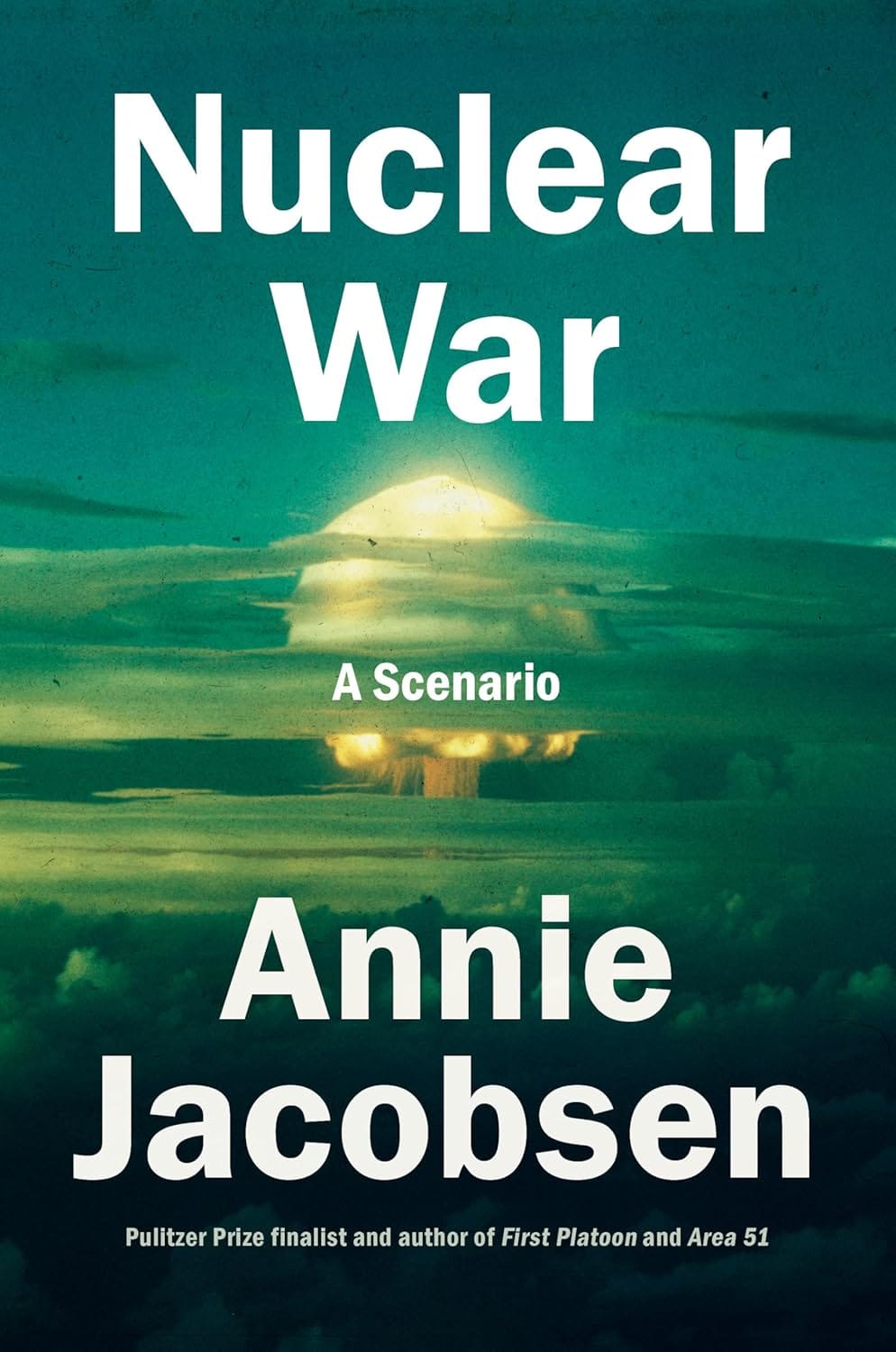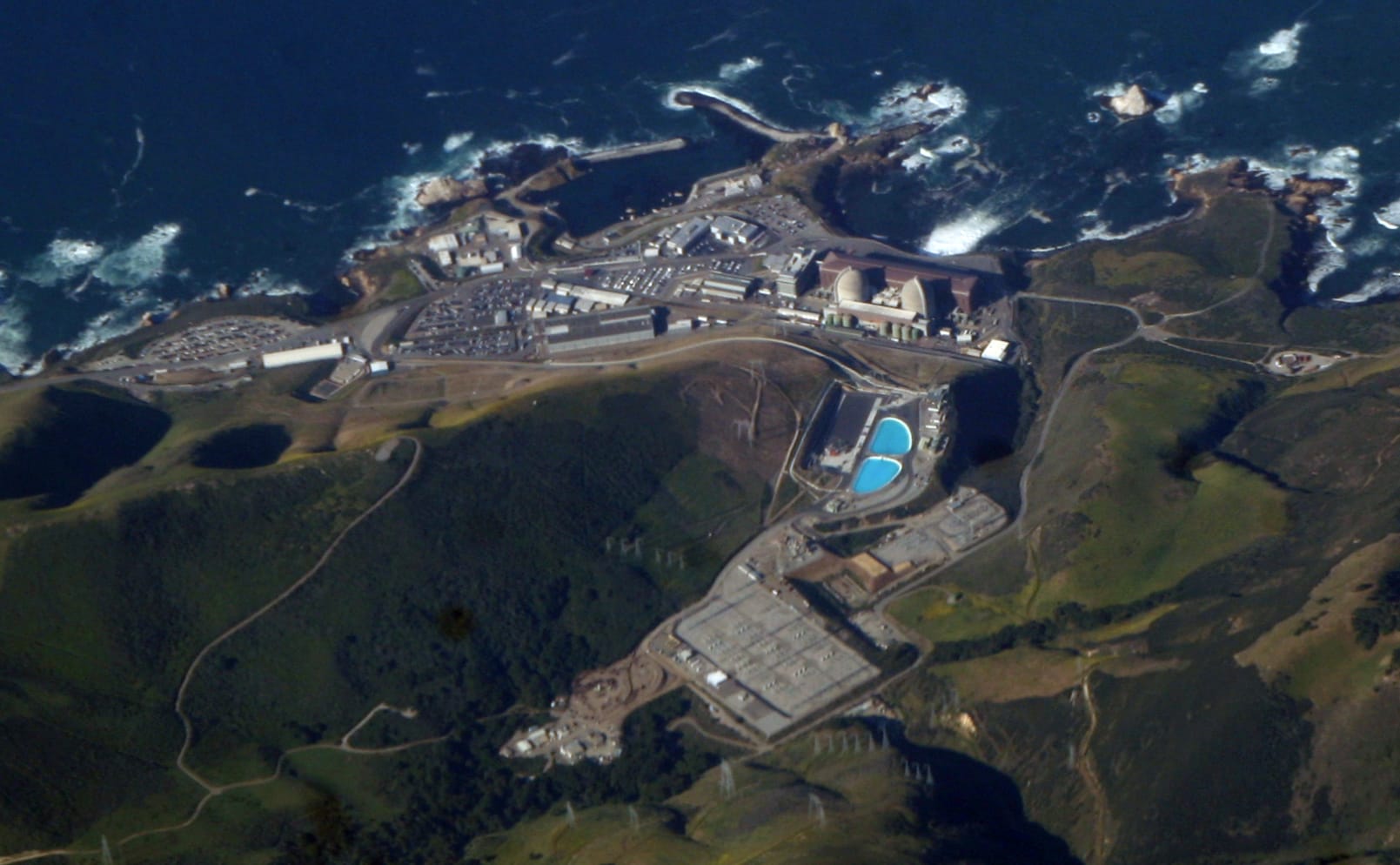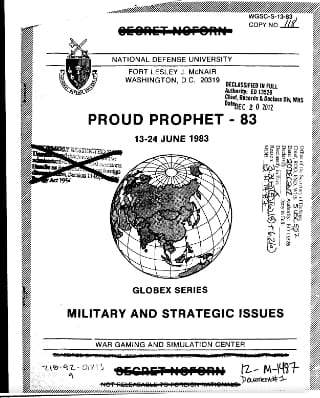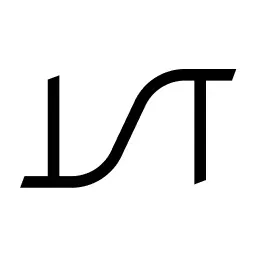On Annie Jacobsen’s "Nuclear War: A Scenario"
The only good news is that this hasn't happened as of yet.

In the 2010 documentary Countdown to Zero, one scientist tell us, “[A nuclear weapon detonation] is a low probability event. But low probability events happen all the time.”
It seems certain to me—certain—that our civilization will end by nuclear exchange. But when?
In Annie Jacobsen’s Nuclear War: A Scenario, the When is a horrifying, mechanized, implacable Right Now.
At any given moment, including this one, “The world could end in the next couple of hours.”

The Structure
Nuclear War: A Scenario uses a heavy framing device to structure and advance its story.
Why are frames interesting? Because they can box and sequence information, because they can organize a narrative, and because they can do interesting things.
Frames, in narrative like fiction, can bring an additional layer of order to the story.
Bram Stoker's Dracula is framed as a body of letters and journal entries. Max Brooks' World War Z is framed as an oral history. Frankenstein. The Shadow Over Innsmouth. House of Leaves.
The professional services firm EY uses a striking yellow rhombus in their advertising to draw the eye and frame certain points in imagery. Absolut Vodka uses their bottle silhoutte the same way. National Geographic's iconic yellow rectangle.
The television series The Office used the framing device of a fictional documentary to organize its storytelling.
The framing device in Jacobsen’s book is effective and well-chosen. It's a clock.
And, like a clock, it moves at an inexorable and maddeningly steady pace. Second by second, we march toward doom. This is a well-guided tour of the mechanics and functions of nuclear Armageddon.
If this was a history of the development of nuclear arms, the arms race, close calls, and/or a guidebook for disarmament, it would be serious, thoughtful, alarming and provocative.
Funneled through the meatgrinder of this single hour-long scenario, though, the effect is appalling.
The voice of the book is clinical and dispassionate. The details and events are starkly apocalyptic. The "real-time" framework lays bare the folly of belief in deterrrance or de-escalation once that inevitable and fateful command is wrongly interpreted or issued by the wrong man.
The frame isn't a gimmick. It's a pre-emptive autopsy of civilization's last hour.
The Scenario
The book advances through a highly structured scenario:
Part I. The Buildup (Or, How We Got Here)
Part II. The First 24 Minutes
Part III. The Next 24 Minutes
Part IV. The Next (and Final) 24 Minutes
Part V. The Next 24 Months and Beyond (Or, Where We Are Headed after a Nuclear Exchange)
Interspersed with brief history lessons on notable components, individuals and side effects of the nuclear war machine, the scenario is a punishing march through the unimaginable madness of a manufactured apocalypse.
It’s a journalistic and speedy book, not without the qualities of a thriller, and overwhelmingly successful in its argument for disarmament.
If you're susceptible to depression, think before reading.
II. The First 24 Minutes After Launch
The scenario begins at 4:03 a.m. in an empty field in North Korea.
There, at that time, a Hwasong-17 Intercontinental Ballistic Missile launches.
Within “a few tenths of a second after ignition”, the US Space-Based Infrared System of Satellites detects “fire from the missile’s hot rocket exhaust through the cloud cover.”
It has happened.
Nuclear deterrence—the comical fictional understanding between Weapons States that one will never pre-emptively strike another because to do so would then gurantee the loss of the aggressor's own state—has failed.
It’s only a matter of minutes now before the silence after Armageddon is finally heard by no one.
US installations receive this launch data in one to three seconds.
Fifteen seconds after launch, US combat pilots run toward their jets.
In less than a minute, the North Korean ICBM’s trajectory is better understood.
Invented in 1957, ICBMS “exist to kill millions of people on another side of the world.” It would take 33 minutes for an ICBM—which cannot be recalled—to cross the world from North Korea to the east coast.
This is the speed of Nuclear War. This is the speed of Escalation.
Nine countries possess Nuclear Weapons: the US, Russia, France, China, the UK, Pakistan, India, Israel and North Korea. Only Pakistan does not also have ICBMs
The US has some 400 ICBM underground missile silos across the country. North Korea’s are road-mobile—an advantage.
It is the policy of the United States and Russia to maintain launch-on-warning or "hair trigger alert" status. This means that when these nation’s become aware of a nuclear launch against them, they are always prepared to launch back instantly upon firing order from the President.
They would not wait to absorb a nuclear blow.
Should that warning be incorrect—should mis or disinformation be received and ingested—these weapons states stand ready (on “Hair-Trigger Alert”) to end the world regardless.
This self-evidently increases the likelihood of a civilization-erasing accidental nuclear war. President Bush vowed to end this policy, but did not. The same is also true of Presidents Obama and Biden. Launch on Warning is still official US policy.
The US President is notified 3 minutes and 15 seconds after the first North Korean launch. He then has six minutes to “decided which nuclear weapons to launch in response.”
The US president has "sole authority to launch America’s nuclear weapons. The president asks permission of no one.”
The US President must then order one of the nuclear responses listed in “the black book” the nuclear football that travels with the president’s mil aide at all times. But because at least one ICBM is heading for DC, the president is physically moved into Marine One to be taken to the Raven Rock facility in Pennsylvania.
US nuclear-armed submarines move into position to execute a decapitation attack against North Korea. The speed with which nuclear subs can launch nuclear weapons makes them “handmaidens of the apocalypse.”
They can end the world, generate their own power, oxygen, and drinking water. “If Washington was attacked by a Russian sub 1,000 km from our coast,” the time to impact would be seven minutes.
In the scenario, a second ballistic missile is then launched from submarine toward the West Coast.
The second target is the Diablo Canyon Power Plant in California. Attacking a nuclear reactor with a nuclear missile guarantees a thousand-years-long nuclear catastrophe.

The Diablo Canyon Power Plant is gone.
In Marine One, the US President finally authorizes a particular strike configuration against the Korean Peninsula.
In Wyoming and elsewhere, ICMB silo doors open and our nuclear response is released.
The Russian President has not yet been reached by telephone.
III. The Next 24 Minutes
The Pentagon is struck and Washington DC is atomized. Wireless emergency alerts hit cell phones nationwide: “US under Nuclear attack. Seek immediate shelter. This is not a drill.”
Videos of mushroom clouds circulate online before social media platforms crash.
Anarchy and panic ensue. Residents try to flee the cities. The President has not addressed the nation and never will. #EndoftheWorld
History Lesson: “Proud Prophet War Game”

In 1983, under the orders of President Reagan, game theorist Thomas Schelling designed a nuclear war game called “Proud Prophet.” Its purpose: to show what happens when deterrence fails.
Every day for two weeks, Schelling and his team of 200 gathered at the National War College to simulate different nuclear war scenarios. The outcome was always the same: Armageddon.
Regardless of who initiates nuclear war and under what circumstances, regardless of who is involved or uninvolved, each scenario always ended with “US, Russia, and Europe totally destroyed.”
“There is no such thing as de-escalation” once Nuclear War starts.
Bolt Out of the Blue
In this scenario, North Korea (for reasons unknown) launches “a bolt out of the blue” attack against a California nuclear power plant, then the Pentagon. The US launches a decapitation strike over the North Pole and Russia toward North Korea.
The Russian President, six floors underground in a hardened nuclear bunker somewhere in Siberia, interprets this as an unprovoked attack against Russia. He thinks of the US lies that led to the war in Iraq and ultimately regime change.
As in America, the Russian President is the only man who can approve the launch of the Russian nuclear arsenal which also stands at hair-trigger alert.
Russia becomes the third weapons state to launch in less than an hour.
RT-2PM2 "Topol-M" intercontinental ballistic missile. Mil.ru
IV. The Next and Final 24 min
A US aerospace data facility in Colorado detects the launch of Russian weapons. The acting US President, now hidden within the Raven Rock Mountain Complex in Pennsylvania, reacts and now truly does authorize a counter-launch against Russia.
Escalation continues.
Nuclear devastation strikes North Korea and the border of China. Unimaginable death and destructions falls across NATO countries and Europe, and the United States, then Russia.
This is full scale nuclear exchange. It is the complete and permanent end of our civilization. And this was all avoidable.
V. The Next 24 months and beyond
24 thousand years later, “genetically compromised” humans–whoever they are, whatever form they take—live underground.
Perhaps someday they would discover some ruin of ours and wonder what it was, who built it, and what happened to that ancient people.
So, not a great outcome for our 300,000 year old species.
We're Doomed Idiots
The Silurian Hypothesis
“How do you know we’re the only time there’s been a civilization on our own planet?” (Frank, "Was There a Civilization on Earth Before Humans?", The Atlantic, 2018)
In 2018, astrophysicists Gavin Frank and Adam Schmidt published a paper in the International Jounral of Astrobiology titled "The Silurian Hypothesis" exploring how we might indirectly detect evidence of a past industrial civilization on this planet, or the Moon, or Mars.
They argue not that such past civilizations existed, but for a testing strategy to discover evidence if any had. What evdence? Not monuments or artifacts. Instead, it would be indirect; nuclear waste and/or other "physicochemical tracers for previous industrial civilization."
Earth is 4.5 billion years old. Humanity has existed in its present form for some 300,ooo years. Industrial civilization is less than 200 years old. If a previous, social, terrestrial and industrial civilization had existed for 10,000 years, we might never discover it within the unthinkably vast funnel of deep time.
The Fermi Paradox, The Drake Equation, and The Great Filter
In 1950, physicist Enrico Fermi famously asked, if the universe is so old, so vast, and so rich in planets potentially capable of supporting life, why haven’t we seen any sign of intelligent extraterrestrial civilizations? "Where is everybody?"
Statistically, we shouldn't be alone, right? The Drake Equation, formulated in 1961, suggests that even with conservative assumptions, intelligent life should have emerged many times across the galaxy.
Perhaps there has been another intelligent terrestial or extraterrestrial civilization. Perhaps there have been thousands. Perhaps more. What happens to them? Do they all terminate by way of a "Great Filter"?
Is Nuclear War that Great Filter? Do civilizations inevitably create and deploy weapons of capable of self-erasure? Do they ultimately leave behind nothing detectable across time but chemical tracers?
What is the mathematical argument that we have brought ourselves to the gates of the Great Filter?
It could all end in a flash, in this moment, or the next, or the next.
Annie Jacobsen
Jacobsen, a graduate of Princeton, would make an excellent X-Files character. She writes about national security, secret government programs and military technology.
Her other books are:
- Terror in the Skies: Why 9/11 Could Happen Again. 2005
- Area 51: An Uncensored History of America's Top Secret Military Base. 2011
- Operation Paperclip: The Secret Intelligence Program that Brought Nazi Scientists to America. 2014
- The Pentagon's Brain: An Uncensored History of DARPA, America's Top-Secret Military Research Agency. Little, Brown and Company. 2015.
- Phenomena: The Secret History of the U.S. Government's Investigations into Extrasensory Perception and Psychokinesis. 2018
- Surprise, Kill, Vanish: The Secret History of CIA Paramilitary Armies, Operators, and Assassins. 2019.
- First Platoon: A Story of Modern War in the Age of Identity Dominance. 2021.
The Must-Knows
What is Nuclear War?
Nuclear War would be a conflict between Nation States exchange nuclear weapons attacks. It has never happened--predicated on Nuclear Deterrence (or Mutually Assured Destruction)—but once it begins it cannot be stopped or de-escalated. It will end the world.
How likely is Nuclear War?
As of this writing, The Doomsday Clock is set to 89 seconds to midnight. This is the closest The Bulletin of Atomic Scientists have ever set the symbolic clock.
Why now?
They write: "We set the clock closer to midnight because we do not see sufficient positive progress on the global challenges we face, including nuclear risk, climate change, biological threats and advances in disruptive technologies...

"The 2025 Clock time signals that the world is on a course of unprecedented risk, and that continuing on the current path is a form of madness... The United States, China, and Russia have the prime responsibility to pull the world back from the brink. The world depends on immediate action."
Also, Trump—arguably the most powerful person on the planet—is a mad man.
Jacobsen told The Guardian, "You would want to have a commander-in-chief who is of sound mind, who is fully in control of his mental capacity, who is not volatile, who is not subject to anger. These are significant character qualities that should be thought about when people vote for president, for the simple reason that the president has sole authority to launch nuclear weapons."
Which countries have nuclear weapons, and how many do they possess?
As of this writing, nine countries officially possess nuclear weapons, with global stockpiles totaling around 12,500 warheads. However, only a portion of these are actively deployed.
- Russia and the U.S. together control nearly 90% of the world’s nuclear weapons.
- China is the fastest-growing nuclear power, prompting strategic shifts globally.
- Smaller states like Pakistan, India, and North Korea are expanding or refining their arsenals in volatile regional contexts.
- Israel remains deliberately opaque, but is widely recognized as a nuclear state.
While the total number of warheads has declined since the Cold War, the readiness, accuracy, and lethality of modern nuclear forces have increased.
Putin has threatened the use of a "tactical Nuclear detonation" in his war on Ukraine. What does that mean?
A “tactical nuclear detonation” would be a smaller, “lower-yield” nuclear weapon deployed on a battlefield to destroy military targets like troops or equipment. These weapons can be as powerful as the bombs that destroyed Hiroshima and Nagasaki.
From PolitiFact: “"There are no military targets in Ukraine that Russia could destroy with a nuclear weapon that it couldn’t also destroy with conventional weapons," [Matthew Bunn, a nuclear policy analyst at Harvard University’s Kennedy School of government] said. This means that the advantage of a nuclear weapon "would be its shock value."
If the war goes badly enough for Russia, Putin might pursue a nuclear detonation in desperation. For instance, he might do it if he is "so desperate to demonstrate power and show that he has somehow achieved a win," said Mai’a K. Davis Cross, a professor of political science and international affairs at Northeastern University.”
What would happen if a nuclear bomb were detonated in a major city?
Here's a NukeMap tool so you can toy with the details of a doomsday device deployed near you.

If a nuclear weapon detonated in a major city, that city and everyone and everything in it would be destroyed. That location would be uninhabitable for decades.
- Vaporization Zone (0.12–0.21 miles from ground zero): Everything within this radius—including people, buildings, and infrastructure—would be vaporized instantly by the blast. If a 15-kiloton bomb (the size detonated over Hiroshima) was used, this area would span roughly 0.12–0.21 miles.
- Severe Structural Damage (1 mile+): Every building collapses, streets are unusable, fires spontaneously ignite from ruptured gas lines.
- Casualties: Tens of thousands die instantly from the blast and shockwave. Hundreds of thousands suffer injuries including lung damage, internal bleeding, and traumatic wounds from flying debris. In Hiroshima, 100,000+ died immediately.
What can I do to support or advance nuclear disarmement?
"According to a 2019 Statista poll, nuclear disarmament fails to rank among even the top twelve issues that young people care about today." (The bomb and us: Why Gen Z should care about nuclear disarmament. Columbia Political Review.)
The banning of nuclear weapons is, in my view, a moral imperative.
If you trust our leaders or our species to resposibly manage military technology that can end humanity forever, tell me what you know.
We're alone. We're special. And over hundreds of thousands of years, we've developed language, culture, arts and science to explore the worlds outside and within us. For 80 years, we've had the ability to destroy our civilization, but we have not–yet.
80 years. One lifetime. It's nothing.
Can anyone be certain that our blind, warring, and spectacularly intellectually limited species will make it another lifetime without triggering—intentionally or not—a full-scale nuclear, and then another, and another, in perpetuity?
As the reader has by now observed, I am no expert. But it seems apparent to me that we must urgently reduce the global nuclear weapons stockpile, and aggressively and strategically dismantle the political, technological and cultural onramps to Armageddon.
Here are some reputable organizations that provide information and engagement opportunities:
SIPRI (Stockholm International Peace Research Institute)
ICAN (International Campaign to Abolish Nuclear Weapons)
